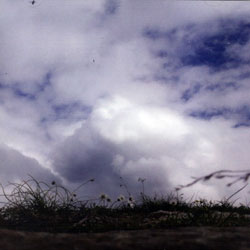
Musicians creating abstract electroacoustic compositions walk something of a tightrope. Essentially a genre of sound collage, there is little to constrain the choice of source materials, much less their ultimate time of occurrence in the resulting pieces. Each stylist must somehow find his or her own logic (or intuition) as to how these musical tapestries should unfold. Too little constraint runs the risk of creating pieces that, as Toynbee once described history, are just "one damned thing after another." Too much constraint tends to stifle creativity and/or push the artist uncomfortably closer to more marketable (often danceable) forms of electronica. On Electricals, EKG (Kyle Bruckmann and Ernst Karel) serve as a fine example of how to navigate this divide.
Bruckmann and Karel were naturals for forming an electro-acoustic duo. They are both classically trained instrumentalists (oboe/english horn and trumpet, respectively) attracted to the wider sonic palette afforded by field recordings and analog electronics. The two met as members of ensembles performing New Music compositions, discovered their mutual interests, and eventually formed EKG. Bruckmann is now in the Bay area and Karel in Boston, but their collaboration continues, albeit on a more limited basis.
EKG's feel for how their pieces progress is a mature one. It seems largely to be based on the creation of and shuttling through distinct aural territories. Quiet mechanical hums form the ground of the soundscapes, and a huge variety of analog clicks, whispers, scrapes, etc. serve as the features of and figures in the sonic tableaus. This is an aesthetic seemingly in love with the sounds of spaces featuring electrical equipment; spaces such as, perhaps, a studio in the downtime between sessions, when mikes are being clicked on and off, patch cords are snapping into place, and amps hum to themselves in the quiet-but-insistent tones of tinnitus.
But it is the progression through these various environments that keeps the listener engaged. In lesser hands the rather subtle materials and drones could fade into the mental background. However, the shifts EKG create in the framing soundscape are often abrupt yet understated. The often eerie effect, in visual terms, is something like switching among security monitors in some Kafka-esque industrial environment. In fact, this music could be considered a darker version of surrealism — the more ominous counterpart to the absurdism of improvisers like guitarist Davey Williams and saxophonist Jack Wright. Insofar as surrealist musicians provide soundtracks to dreams, EKG seem drawn to the haunting ones that leave one with an inexplicable sense of foreboding.
Occasionally the sounds come more to the foreground. For example, some parts of "current" are loud by the standards of most of the CD: electronic burbles, buzzes, and occasional roars fade in and out against the mechanical hum. Eventually the sounds become more thunderous, and the listener is in the midst of a electrical storm instead of sheltered in a factory or laboratory (and here, perhaps, we find the impetus for the atmospheric cover art). Here and there, as near the end of "drift," Bruckmann's double reeds fade briefly into the mix. The instruments are tastefully integrated into the mix, but seem a bit out of place on the CD, since the vast majority of the other sounds is drawn from things electronic.
These dark, austere performances (some of which were recorded live) mark a step forward in EKG's evolution as a duo. And as electroacoustic compositions, they set a powerful example of the care performers and composers should devote to how pieces develop.
Comments and Feedback:



More Recent Reviews, Articles, and Interviews @ The Squid's Ear...


|

